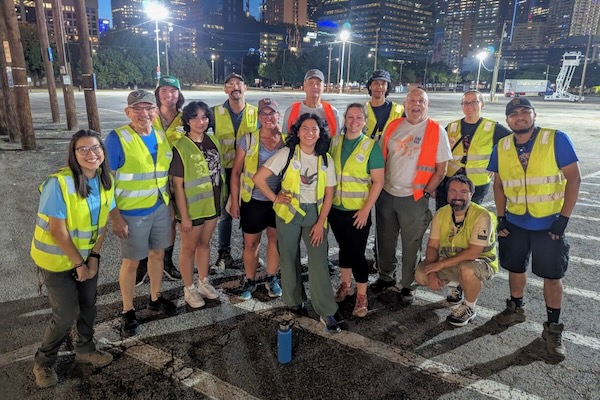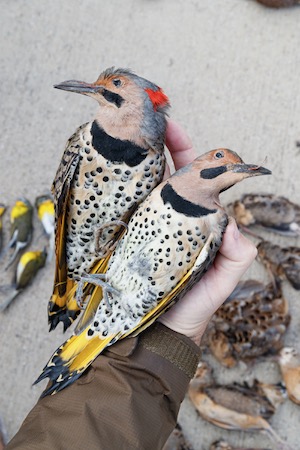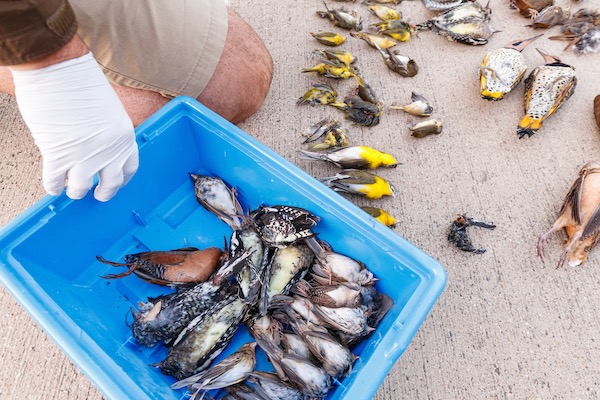
The Lights Out Texas campaign is urging Texans to turn off their outdoor lights from 11 p.m. to 6 a.m. starting March 1. Courtesy of Texas Conservation Alliance.
March 1, 2024
It’s time to go dark for the birds.
The Lights Out Texas campaign is asking all Texans to turn off their outdoor lighting from 11 p.m. to 6 a.m. March 1 to June 15 to help migrating birds during spring migration.
LONE STAR FLYWAY
Texas plays a big role in bird migration.
More kinds of birds have been found in Texas than any other state: just over 600 species, according to Texas Parks and Wildlife Department. More than half of those are migratory birds, which funnel through Texas on their way to and from wintering grounds in Mexico and Central and South America.
Each year, during fall and spring migrations, nearly two billion birds travel through Texas, typically at night.
They use the moon and the stars to navigate.
 Volunteers participate in a Lights Out Survey Leader Training in downtown Dallas fall 2023. Courtesy of Texas Conservation Alliance.
Volunteers participate in a Lights Out Survey Leader Training in downtown Dallas fall 2023. Courtesy of Texas Conservation Alliance.
But along the route, they cross vast metropolitan areas blazing with light.
Texas contains three of the top 10 cities in the U.S. most dangerous to birds due to light pollution.
Houston and Dallas are ranked second and third most dangerous cities in the U.S. for birds, respectively, with Chicago in the top spot.
San Antonio is ranked number 10 during spring migration.
Light attracts and disorients these night-flying birds, which can exhaust them as well as cause collisions with buildings.
According to Mei Ling Liu, community conservation director at Texas Conservation Alliance, it’s not only tall buildings that are responsible for collisions.
“More cases happen at low-rises and homes,” said Liu.
A 2014 study done by Scott Loss from Oklahoma State University estimated that 500,000 birds are killed annually by high-rise buildings, while an estimated 340 million are killed by low-rise buildings and 250 million by residential homes. That’s why the campaign is directed at residents as well as building managers.
“We want to build support from the entire community,” said Liu. “It’s a simple action everyone can do at home — close curtains, turn off the lights or install motion-sensing lights as an alternative to keeping lights on all night.”
CATASTROPHIC CRASH
 A pair of northern flickers were among the carcasses found during a 2021 survey in downtown Dallas. Below them are the remains of American woodcocks and yellow-breasted chats. Photo by Sean Fitzgerald.
A pair of northern flickers were among the carcasses found during a 2021 survey in downtown Dallas. Below them are the remains of American woodcocks and yellow-breasted chats. Photo by Sean Fitzgerald.
A major bird collision event inspired the Houston Audubon Society to launch the Lights Out Texas program seven years ago.
In May 2017, workers at the American National Building, the tallest skyscraper in downtown Galveston, discovered nearly 400 birds of brilliant hues dead on the ground, according to the Guardian.
“These are showy, beautiful birds that bird watchers really get excited to see,” said Richard Gibbons, conservation director at the Houston Audubon.
Since launching, the program has grown statewide due to standardization by Texan by Nature with other leading organizations.
In addition to the Houston Audubon Society and Texan by Nature, founding partners include the Cornell Lab of Ornithology, Texas Parks and Wildlife Department Nature Trackers, Texas Conservation Alliance, Dallas Zoo, Perot Museum of Nature and Science, Texas A&M University – Biodiversity Research and Teaching Collections, Colorado State University and Oklahoma State University.
Today, the effort is facilitated by Audubon Texas in collaboration with conservation nonprofits, universities, governmental organizations and Texans dedicated to the conservation of birds.
The campaign’s goal is to reduce migratory bird mortality by increasing statewide participation of cities and building owners to turn off non-essential lights.
Locally, Dallas-based Texas Conservation Alliance is the lead organizer of the program, which coordinates efforts in Dallas and Fort Worth.
According to Liu, Reunion Tower in Dallas has been a trailblazer, participating every year since the program started in DFW and has committed again this spring.
In Fort Worth, Downtown Fort Worth Inc. has rallied support by its members, including Bank of America Tower, Burnett Plaza, Cash America, First on 7th, Fort Worth City Hall, Frost Tower, Pier One Building, 777 Main, The Tower, Trinity Terrace and the Wells Fargo Tower.
This week, the city of Cedar Hill announced support for the program.
TCA is also working with a team at the Texas A&M campus in College Station .
HOW MANY BIRDS ARE BEING KILLED IN DFW?

Volunteers for Lights Out Texas collect birds that appear to have been killed by colliding into buildings in downtown Dallas during spring migration in 2021. Photo by Sean Fitzgerald.
A big part of Texas Conservation Alliance’s efforts have gone into documenting bird mortalities.
Since, fall of 2020, TCA and a group of volunteers have surveyed the Dallas downtown area for 80 days, each spring and fall migration period. In the early morning hours, volunteers fan out around 10 buildings to collect carcasses of birds killed by collisions with buildings during the night.
Over seven migrating seasons, Dallas volunteers have recorded 2,350 bird deaths. In addition, nearly 234 birds were rescued and taken to rehab.
The deceased and injured birds represented 105 species with Lincoln’s sparrow, white-throated sparrow, Grasshopper sparrow, American woodcock and orange-crowned warbler among the top five species found.
In 2023, a Fort Worth team started performing surveys in downtown Fort Worth. Last year, volunteers recorded 233 bird deaths and nearly 40 rescues.
Liu says she encourages residents to participate in the survey and see the reality behind the statistic.
“It's really much more impactful when you really see the birds dying in front of you,” she said.
Liu points out that light pollution is a larger environmental issue that we should all be concerned about.
“Light pollution is not just about the birds. It's about the plants and the pollinators and the people. Studies have been done that show artificial lights really impact human health.”
OUTREACH
 Lights Out Fort Worth Coordinator Mariah Campos, right, shares information with the public. Photo courtesy of Texas Conservation Alliance.
Lights Out Fort Worth Coordinator Mariah Campos, right, shares information with the public. Photo courtesy of Texas Conservation Alliance.
While the surveys have provided helpful data, this year, TCA will reduce the number of survey days and shift more emphasis on outreach..
The next event, Science Under the Stars, will be held March 22, 7 p.m. to 9 p.m.at Collin College Plano Campus, 2800 E. Spring Creek Parkway in Plano.
 SIGN OF THE TIMES
SIGN OF THE TIMES
You can show your support for the Lights Out campaign by picking up a Bird Migration Alert yard sign. The signs are printed on both sides so they can be used for both spring and fall migration. They are free if picked up at a Lights Out bird survey or special event. They can also be purchased online on the Texas Conservation Alliance website for $35. Shipping is included. Purchase here.
For more information about Lights Out DFW events or volunteering in bird surveys, contact Texas Conservation Alliance or visit Lights Out DFW online.
RELATED ARTICLES
Lights Out Texas' aims to save migrating birds
Downtown Fort Worth to dim lights to help migrating birds
Dead bird count in Dallas informs light pollution campaign
'Lights Out' campaign is gaining momentum, say organizers
Stay up to date on everything green in North Texas, including the latest news and events! Sign up for the weekly Green Source DFW Newsletter! Follow us on Facebook, X and Instagram. Also check out our new podcast The Texas Green Report, available on your favorite podcast app.









